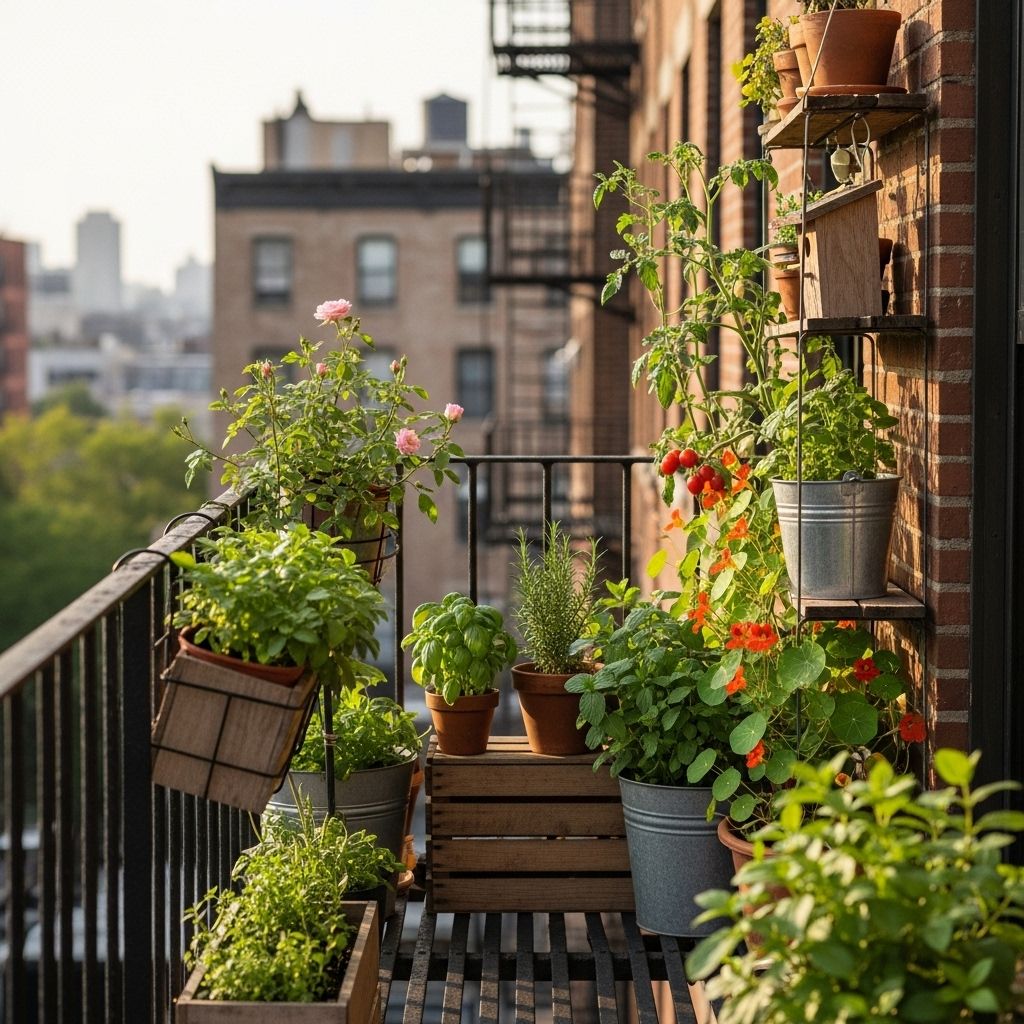How to Grow a Fire Escape Garden: Urban Oasis in Small Spaces
Turn unused metal stairs into a lush green retreat teeming with fresh produce.

Image: HearthJunction Design Team
City life often means sacrificing green space, but a fire escape garden lets urban dwellers reclaim a slice of nature. Compact, creative, and surprisingly productive, fire escape gardens bring color and flavor just outside your window. This guide will walk you through everything you need to know, from legal pitfalls to container selection, smart plant choices, and expert maintenance tips.
Table of Contents
- Why Start a Fire Escape Garden?
- Is Fire Escape Gardening Legal and Safe?
- Pros and Cons of Fire Escape Gardens
- Best Plants for Fire Escape Gardens
- Planning & Setting Up Your Fire Escape Garden
- Choosing Containers and Supplies
- Maintenance: Watering, Feeding, and Upkeep
- Frequently Asked Questions (FAQs)
Why Start a Fire Escape Garden?
Urban environments rarely offer backyards or plots, making fire escapes an appealing alternative for nature lovers. These mini-gardens are not only a source of fresh herbs, veggies, and flowers, but also:
- Improve air quality by adding greenery
- Offer privacy and visual interest to city dwellers
- Provide space for small-scale food production right outside your window
- Create a personal retreat for relaxation, even in the heart of the city
Is Fire Escape Gardening Legal and Safe?
The legality and safety of fire escape gardening is the first—and most critical—consideration. Many cities and landlords strictly regulate what can be placed on fire escapes.
- Before you start, always check your local fire codes and building regulations for fire escapes. Some municipalities ban all items on fire escapes; others allow them with restrictions as long as passage remains unobstructed.
- Your garden must never block access required in an emergency. Leave pathways wide enough for quick, safe passage at all times.
- If unsure, ask your landlord or property manager in addition to reviewing local regulations.
Tip: If rules prohibit items on fire escapes, consider removable window boxes inside the railing or hanging baskets hooked outside the bars—always prioritizing safety.
Pros and Cons of Fire Escape Gardens
Like any urban garden solution, fire escape gardening has clear benefits as well as drawbacks. Consider these before you begin:
| Pros | Cons |
|---|---|
|
If you're concerned about maximizing your harvest in limited conditions, don't miss our essential guide to small space vegetable gardening. This guide will introduce you to productive plants and innovative techniques that align perfectly with urban gardening challenges, ensuring you thrive even in restricted spaces. |
Best Plants for Fire Escape Gardens
Space is at a premium, so focus on compact, high-yield, or decorative plants that thrive in containers. Sunlight can vary dramatically, so assess light levels daily before choosing what to grow.
Top Edible Choices
- Leafy greens: Lettuces, arugula, and kale are perfect cut-and-come-again crops for repeated harvests.
- Herbs: Basil, mint, oregano, thyme, chives, and parsley flourish in pots and need only modest space.
- Tomatoes and peppers: Pick dwarf or bush varieties that will not crowd walkways.
- Strawberries: Thrive in hanging baskets or window boxes, producing sweet fruit and decorative foliage.
Top Decorative Plants
- Succulents and small cacti: Low maintenance, perfect for sunny spots
- Moss rose (Portulaca): Ideal for hanging pots, spills gracefully, and produces vibrant blooms
- Nasturtiums: Edible flowers and attractive trailing growth
- Vines: Small, lightweight vines such as sweet peas add greenery without too much bulk
Tip: Prioritize small or upright varieties, and avoid aggressive vining or bushy plants that may quickly overwhelm your space or impede escape routes.
Planning & Setting Up Your Fire Escape Garden
With space and weight limitations, preparation is essential. Follow these key steps:
- Measure Your Space: Map out available areas. Account for width, depth, and height—don’t block exits or access ladders.
- Assess Sunlight: Fire escapes can be full sun, part sun, or mostly shade depending on building orientation and neighboring structures. Track sunlight exposure for a full day to match plant requirements to site conditions.
- Choose Plants for Your Conditions: Herb and leafy vegetables for shadier corners; sun-loving peppers, tomatoes, and moss rose for bright, exposed metal sections.
- Weight Check: Lightweight plastic or resin planters are safer than clay or ceramic. Keep total weight (plants, soil, pots, and water) far below load limits of your fire escape structure.
- Accessibility: Keep containers arranged so they’re easy to water, tend, and harvest—avoid placing anything where it could tip or fall onto those below.
Choosing Containers and Supplies
Containers are the backbone of any successful fire escape garden. Thoughtful choices increase safety, maximize yield, and reduce mess.
Container Features to Prioritize
- Drainage: Every pot should have holes to prevent waterlogging. Consider saucers or trays to catch excess and avoid drips on your neighbors or building facade.
- Size Matters: Larger containers allow more room for roots and reduce the risk of soil drying out, but must be balanced against space and weight limits.
- Material: Lightweight resin, plastic, or fabric pots are portable, affordable, and safe for elevated sites. Avoid stone or unglazed clay pots for the upper tiers unless they are very small.
- Hanging Options: Baskets, over-rail planters, or wall-mounted pockets can maximize vertical space and keep walkways clear.
Other Essential Supplies
- Potting Soil: Use a high-quality potting mix (not heavy garden soil) to keep containers light and plants healthy.
- Fertilizer: Container gardens need regular fertilizing, as nutrients leach quickly with frequent watering. Choose balanced, slow-release fertilizers or dilute liquid feeds every few weeks.
- Watering Can or Hose: A lightweight watering can with a long spout lets you reach across containers without shifting things around.
- Plant Labels: Keep track of what you’ve planted, especially if you’re experimenting with different varieties.
- Protective Mats/Saucers: Catch drips and protect metal flooring from rust and staining.
Maintenance: Watering, Feeding, and Upkeep
Fire escape gardens are high-maintenance due to wind exposure, sun, and small soil volumes. Set a routine to keep plants thriving and your set-up safe.
- Watering: Container soil dries out fast, especially on sunny or windy fire escapes. Water daily in hot weather, and check for dryness before top-ups to avoid overwatering.
- Fertilizing: Add a balanced liquid or slow-release fertilizer every few weeks. Frequent watering depletes soil nutrients, leading to yellowing and poor yields if uncorrected.
- Pruning & Harvesting: Regularly pinch, trim, and cut-back herbs and greens to keep them bushy, prevent overcrowding, and prolong harvest periods.
- Check for Pests: Urban environments attract aphids and mites. Treat early using soapy sprays or manually remove pests as needed.
- Rotate Plants: Shift container positions if you notice uneven sun exposure or stunted growth in sheltered spots.
Always keep your emergency route clear—move planters at the first sign they are impeding movement or access.
Frequently Asked Questions (FAQs)
Q: Is it legal to have a garden on my fire escape?
A: Regulations vary widely by city or building. Always check with your local fire department and building management before installing any permanent greenery. Safety and access are paramount.
Q: What plants are safest and most productive for a small fire escape?
A: Small, container-friendly crops like lettuce, kale, herbs (basil, oregano, mint), peppers, and tomatoes (dwarf types) are excellent. Choose plants with compact habits to avoid overcrowding and keep escape routes clear.
Q: How can I ensure my fire escape garden doesn’t leak or drip on my neighbors?
A: Always use containers with saucers or trays to catch excess water. Water carefully, and avoid runoff by never overfilling. Place pots so that drips do not land on balconies below.
Q: Do I need any special soil or fertilizer?
A: Use a high-quality potting mix and supplement with slow-release or liquid fertilizer every few weeks. Nutrients are quickly depleted in small containers, so routine feeding keeps plants vigorous and disease-resistant.
Q: What should I do if I have to MOVE or clear my garden quickly?
A: Use lightweight planters and portable trays so you can swiftly remove items in an emergency, or at the request of building management or firefighters. Avoid placing anything so large or heavy it cannot be moved by one person.
Conclusion: Turn Your Fire Escape Into a Green Refuge
With planning, creativity, and an eye for safety, any city dweller with access to a fire escape can grow a vibrant urban garden. Even the smallest green space offers a remarkable boost to quality of life, providing fresh food, neighborhood beauty, and a daily connection to nature. Just remember: keep it legal, keep it light, and always keep the way clear.
References
- https://thedirtybird.com/blogs/news/tips-for-a-fire-escape-garden
- https://www.gardeningknowhow.com/special/urban/fire-escape-gardening.htm
- https://www.beprepared.com/blogs/articles/how-to-grow-herbs-and-veggies-on-your-fire-escape
- https://www.redhandledscissors.com/2012/04/30/5-tips-for-successful-fire-escape-and/
- https://www.gardenista.com/posts/how-to-grow-fire-escape-garden-pro-con-small-space/
Read full bio of Srija Burman












